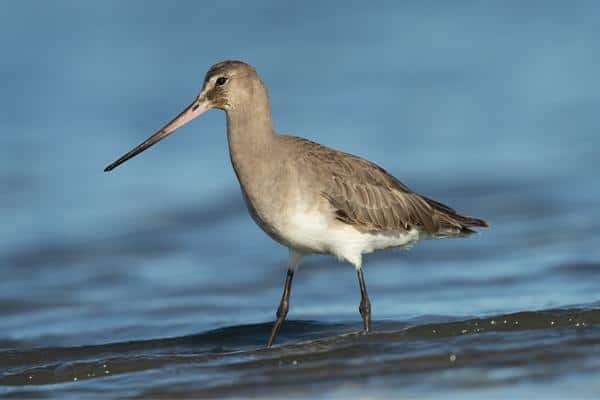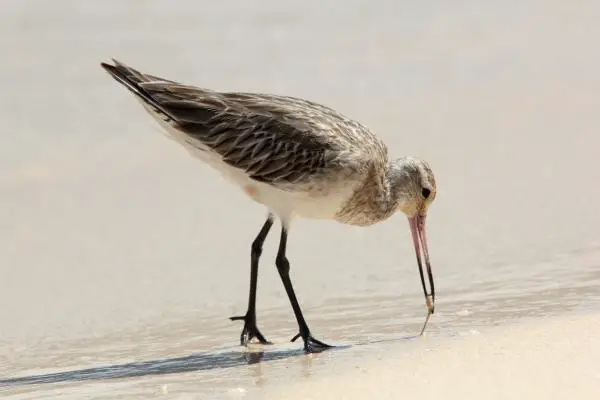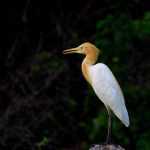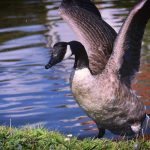Common Name: Hudsonian Godwit
Scientific Name: Limosa haemastica| Size | Diet | Range in Hawaii | Status in Hawaii |
|---|---|---|---|
| 15 in. - 18 in. | insects, crustaceans, worms, and mollusks | O'ahu and Moloka'i | Least Concern |
The Hudsonian Godwit, also known as Limosa haemastica, is a remarkable bird that embarks on long-distance migrations through the Americas. These birds breed in Alaska and the Hudson Bay region and spend their winters in South America.
While it’s rare to spot them in the central Pacific, the Hudsonian Godwit has been recorded in the Marshall Islands, Fiji, and even in Hawaii. In fact, confirmed sightings of these birds have been reported in O’ahu and Moloka’i.
In this article, we’ll take a closer look at the unique characteristics and behaviors of the Hudsonian Godwit and learn more about their presence in the beautiful islands of Hawaii.
Hudsonian Godwit
Appearance

The Hudsonian Godwit is a medium-sized shorebird known for its distinct appearance. It measures approximately 15 to 18 inches (38 to 46 centimeters) in length, making it slightly larger than a typical American Robin. This species has a long, slender bill that curves slightly upward, enabling it to probe the mud for prey.
Its plumage varies depending on the season. During the breeding season, adult Hudsonian Godwits display a rich chestnut-brown color on their upperparts, while their underparts are a striking reddish-orange. In contrast, their non-breeding plumage is paler and more grayish, with mottled brown and white patterns on the upperparts.
Diet
The diet of the Hudsonian Godwit primarily consists of invertebrates found in wetland and coastal habitats. These resourceful birds use their long, curved bills to probe the mud and shallow water, searching for prey such as insects, crustaceans, worms, and mollusks.
They have a specialized feeding technique, inserting their bills deep into the substrate and rapidly extracting prey items. During the breeding season, they may also feed on terrestrial insects and larvae found in grassy areas near their nesting sites.
Hudsonian Godwits are highly dependent on healthy wetland ecosystems, which provide them with an abundant supply of food resources throughout their migratory journey.
Nesting
Hudsonian Godwits nest in the Arctic regions of North America, primarily in Alaska and the Hudson Bay region of Canada. They prefer open tundra habitats near freshwater marshes or ponds. The nesting season typically begins in late May or early June.
The male establishes a territory and performs courtship displays to attract a female mate. The female constructs the nest on the ground, usually in a slight depression or amongst vegetation, using materials such as grass, moss, and leaves. The nest is lined with finer materials for added insulation and comfort.
The female typically lays a clutch of four eggs, which are creamy or olive-brown in color with dark blotches. Both parents take turns incubating the eggs for about three to four weeks until they hatch.
Once the chicks hatch, they are precocial and able to leave the nest within hours. The parents provide care and protection for the young, guiding them to suitable foraging areas and defending them from potential threats.
Behavior

The Hudsonian Godwits exhibit interesting behaviors throughout their annual cycle. During the breeding season, males establish territories and engage in elaborate courtship displays to attract females. These displays involve various aerial and ground-based movements, including aerial flights, swoops, and calls.
Once a pair bond is formed, the male and female work together to build a nest and incubate the eggs. Hudsonian Godwits are known for their remarkable long-distance migrations.
They undertake one of the longest migrations of any shorebird, traveling from their breeding grounds in the Arctic regions of North America to their wintering grounds in southern South America. These migratory journeys can span thousands of miles and require exceptional navigational abilities.
During migration and winter, Hudsonian Godwits congregate in large flocks in coastal wetlands, estuaries, and mudflats. They forage by probing their long bills into the substrate, searching for invertebrates such as insects, crustaceans, and mollusks. They may also feed on small fish and plant matter, depending on the availability of food in their habitat.
Hudsonian Godwits are known to be highly territorial and defend their feeding and breeding areas vigorously. They display aggressive behavior towards intruders, engaging in aerial displays, calls, and physical confrontations to protect their territories. This territorial behavior is especially pronounced during the breeding season when competition for resources and mates is high.
Habitat

The Hudsonian Godwits inhabit a variety of habitats across their range, both during the breeding season and while on migration. During the breeding season, they primarily occur in Arctic and subarctic regions of North America, including wet tundra, coastal marshes, and open grasslands. These areas provide suitable nesting sites and access to abundant food resources.
During migration, Hudsonian Godwits make use of a wide range of habitats as they undertake their long-distance journeys. They rely on coastal areas, including mudflats, estuaries, and saltmarshes, which provide rich feeding grounds with an abundance of invertebrates. They may also utilize freshwater wetlands, shallow lakes, and flooded fields along their migratory routes.
In their non-breeding season, Hudsonian Godwits spend time in the southern parts of South America, particularly in coastal areas, lagoons, and estuaries. These habitats offer favorable conditions for foraging and resting, with access to a diverse range of prey items such as crustaceans, insects, and other small aquatic organisms.
Range
The Hudsonian Godwit is a long-distance migratory bird with a breeding range encompassing Alaska and the Hudson Bay region. During the winter months, it can be found in South America. While sightings of this species in the central Pacific, including the Marshall Islands and Fiji, are infrequent, there have been two confirmed records of Hudsonian Godwits in the Southeastern Hawaiian Islands.
However, distinguishing between Hudsonian and Black-tailed Godwits can be challenging, as both species have been observed in Hawaii. Noteworthy sightings include an adult Hudsonian Godwit on O’ahu in 1987 and documented sightings on O’ahu and Moloka’i in subsequent years. These occurrences suggest that the Hudsonian Godwit may undertake migratory journeys that bring them to the Hawaiian islands.
Conservation Status
The Hudsonian Godwit is currently listed as a species of “Least Concern” by the International Union for Conservation of Nature (IUCN). While the population size of the Hudsonian Godwit is unknown, it is believed to be stable, and the species is not facing any significant threats at the moment.
However, like many migratory birds, the Hudsonian Godwit is still vulnerable to habitat loss and degradation, hunting, and other human activities that can disrupt their migration patterns. Conservation efforts are focused on protecting the breeding and wintering habitats of these birds and reducing the impact of human activities on their migration routes.
Interesting Facts
1. Impressive long-distance migrations
Hudsonian Godwits are known for their impressive long-distance migrations, covering distances of up to 16000 kilometers (10,000 miles) each way between their breeding grounds in the Arctic and their wintering areas in South America.
2.Highly skilled navigators
These godwits are highly skilled navigators and rely on celestial cues, landmarks, and magnetic fields to guide them during their extensive migrations.
3. Distinctive and impressive bill length
Hudsonian Godwits are known for their distinctive and impressive bill length, which can exceed 10 centimeters (4 inches). This long bill enables them to probe deep into the mud or sand to capture their prey.
4. They are highly social
These birds are highly social during migration and can form large flocks, often associating with other shorebird species in feeding and resting areas.
5. Monogamous bird
Hudsonian Godwits are monogamous birds, forming long-term pair bonds. They typically return to the same breeding sites year after year and may even reunite with the same mate.
Frequently Asked Questions
1. How do Hudsonian Godwits communicate with each other?
Hudsonian Godwits use a variety of vocalizations to communicate. These include calls during flight, alarm calls to warn of potential danger, and courtship songs to attract mates.
2. Are Hudsonian Godwits solitary or social outside of the breeding season?
Outside of the breeding season, Hudsonian Godwits are generally more solitary. They tend to forage and rest individually or in small groups, although they may still congregate in larger flocks during migration.
3. How long do Hudsonian Godwits live?
The lifespan of Hudsonian Godwits can vary, but they typically live for about 10 to 15 years. However, some individuals have been known to survive for over 20 years in the wild.
4. Do Hudsonian Godwits have any predators?
Hudsonian Godwits face predation threats from various animals, including avian predators such as gulls, falcons, and hawks. Additionally, ground predators like foxes, raccoons, and minks may target their nests and young.




